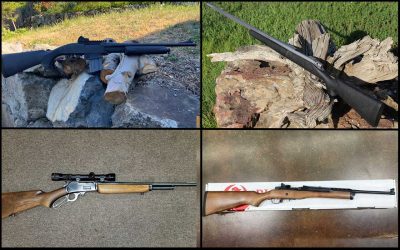
By Paul Rackley, GunBroker.com Editor
Over the last decade or so, long range shooting has jumped in popularity. It can be fun to reach out and touch something at 500 yards or more. However, most areas limit the availability of these kinds of shots. Because of this, hunters benefit more from learning how to hit moving targets.
Sure, no one wants to spook game, but it happens. This could be because the wind shifts, a twig snaps or countless other reasons, including a less than optimal first shot on a stationary target. Regardless of the reason, shooting moving targets is a skill hunters need to learn. Luckily, it’s not that difficult to learn one of the three main methods for moving targets. Even better, the skills required for hitting moving targets are the same whether using a rifle or a shotgun. Of course, shooting game on the move means that both the target and the firearm is moving. This makes knowing what is beyond the target even more important; hunters can’t get locked in on the target and forget about safety; hunters must always know what is beyond the target.
Methods of engaging moving targets
Hitting Moving Targets Via Tracking
Also known as sustained lead, tracking involves swinging with the target. Lead is determined by distance and target speed. The faster the target, the faster the swing needs to be. The lead required at 50 yards on a moderately trotting target is much less than game racing away at 100 yards. Regardless, the firearm must be in front of the target at a determined lead before pulling the trigger. Many hunters prefer to use the tracking method because it provides the best possibility of follow-up shots. This method is especially useful in most wingshooting opportunities.
Swinging Through
The swing through is mostly for when hunters get behind from the jump and are forced to catch up. This can be from a deer or pheasant busting out of the brush by surprise or fumbling the sporting arm when bringing it to the shoulder. For whatever reason, the swing starts behind the target. Here, the lead is created by the speed of the swing, firing when the gun passes the proper lead distance. However, hunters can shift to sustained lead once catching up and firing, possibly providing an opportunity for follow-up shots.

Set Up and Ambush
While probably the least popular, the ambush method works at times. In fact, there are even some specific situations where it can be the best option, such as in thick cover with shooting lanes. The basic idea involves aiming at an opening where game is going to cross and firing when the game appears. To do this properly, hunters need to use open sights or set the scope magnification to where the entire opening can be seen in the field of view. Otherwise, game could get through the sight picture in the crosshairs before the trigger pull.
Related Articles: Need a Deer Rifle for Upcoming Hunting Season?
Follow Through on Moving Targets
Regardless of the method of lead, the most important factor for all three is follow through. When firing at a moving target the idea is to put the shot where the target will be, not where it is. As such, stopping at the point of the shot ensures a miss. Now, hitting a moving target isn’t as hard as some believe, but it also isn’t easy. The brain naturally calculates speed of the target and distance to some degree, but this becomes more difficult as ranges become more distant. Of course, the basic idea is simple, the lead increases at longer distances and decreases at shorter distances.
While the required skills are the same regardless of size, it is typically easier to hit big game on the run. However, those who have the shooting skills to hit smaller game, such as squirrels and rabbits, should have no problems taking down a running deer or elk.
Related Articles: 4 Deer Hunting Essentials You Can Get at GunBroker.com
Related Videos: Hunting & Trapping in the Great Depression | No Lowballers Podcast Episode 2
Related Videos: Specs and Features of Henry 360 Buckhammer Rifles [Video]







